Escape from Monkey Island Preview
Guybrush Threepwood and the rest of the wacky Monkey Island cast are back. We take a detailed look.
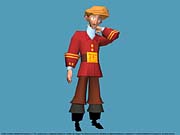
While the Star Wars license is the vehicle that has brought LucasArts to mainstream gamers, it's the company's pedigree of graphic adventure games that continues to impress hard-core fans. Maniac Mansion set the standard for nearly all games in the genre to follow, and LucasArts has since continually been raising the watermark for others with games like Sam & Max Hit the Road, Full Throttle, Day of the Tentacle, and of course, the Monkey Island series. Earlier this year, LucasArts revealed that it would extend the life of the Monkey Island games with Escape from Monkey Island, the fourth entry in the humorous and cleverly written series. The news came as a pleasant surprise to many adventure-game fans who had assumed Grim Fandango to be the genre's swan song. Released two years ago, Grim Fandango was legendary designer Tim Schafer's last graphic adventure game for LucasArts, and despite loads of critical acclaim (it took home our Game of the Year Award for 1998), sales of the game stalled in the US compared to blockbusters like Starcraft. Regardless, the company is hard at work on Escape from Monkey Island, which will prove to be LucasArts' culmination of graphic-adventure experience.
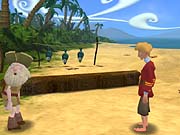
Escape from Monkey Island isn't LucasArts' first 3D graphic adventure, but it is the first Monkey Island game to have that distinction. As a result, a lot of fans of the series have expressed some concern that the transition from 2D to 3D will have a negative effect on the overall appeal of the series. We recently traveled to LucasArts' San Rafael, Calif., offices to take a look at Escape from Monkey Island in its final stages of development. We spoke a bit with the game's lead designers, Sean Clarke and Mike Stemmle, whose previous work includes Sam & Max Hit the Road, The Dig, and Afterlife, and then sat down with the latest build of the game for about an hour. Judging from our time in front of Escape from Monkey Island, it's clear that the humorous antics and addictive gameplay formula of the series haven't been lost on this fourth installment. If anything, Escape from Monkey Island is shaping up to be the series' finest entry. Let's take a look.
The New Story
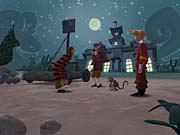
Escape from Monkey Island takes place a few months after the events in the previous game, Curse of Monkey Island. Guybrush is now a married man, having tied the knot with the love of his life, Governor Elaine Marley. However, after spending three months honeymooning in the Caribbean, the couple returns to Melee Island to find things grossly amiss. For starters, Elaine's been gone so long that city hall has declared her officially dead. Guybrush and Elaine's home, the governor's mansion, is under siege by a catapult-wielding pirate. He's apparently been ordered to tear down the house, and like a good government official, he is diligently flinging boulders at the estate... although having a difficult time actually hitting anything other than dirt.
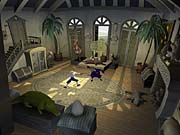
Elaine heads off to city hall to have herself declared "undead" and leaves Guybrush in charge of putting a stop to the pirate's catapult. To do so, Guybrush needs to go into town and solve a series of puzzles. While there, it's revealed to Guybrush that far more sinister workings have been at play while the couple was on their little getaway. A mysterious Australian businessman named Ozzie Mandrill has been buying up land and gentrifying the Tri-Island area at an alarming pace. During a conversation with Meathook, Guybrush finds out that Ozzie challenges land owners to a game of insult something-or-other and defeats them so soundly that they sign over their deeds out of sheer embarrassment. On nearby Lucre Island, Mandrill's commercialism has taken hold and sprouted bourgeois relics like a Planet Threepwood and Starbuccaneers. Ozzie Mandrill is after an ancient voodoo skull that is the ultimate weapon of insult. With it, he'll be able to drive all the pirates out of the Caribbean, leaving it completely ripe for his own picking.
Of course, no Monkey Island game would be complete without the infamous pirate LeChuck, and Escape from Monkey Island is no exception. Guybrush learns that one Charles L. Charles, LeChuck, is running for governor of Melee Island. Adding even further to this plot twist is that LeChuck looks nothing like his former self. Gone is the scowling skull and flaming beard. Instead, LeChuck looks completely human and alive - although he doesn't smell the part. Murray, the loveable talking skull from Curse of Monkey Island, reveals to Guybrush how it was that LeChuck escaped his icy tomb from the end of the third game, but his new appearance will remain a mystery throughout most of Escape from Monkey Island. Finding out how LeChuck became human, or came to look like one at least, is a main objective of the game.
There are other mysteries in Escape from Monkey Island, like figuring out in what capacity LeChuck and Mandrill are working with one another and what happened to all the monkeys of Monkey Island. Along the way to finding the answers to these mysteries, Guybrush will interact with a wide array of characters, both new and old, including Murray, Otis, and Meathook.
Gameplay
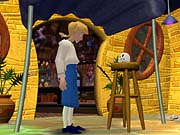
While the new 3D graphics might be the biggest change in Escape from Monkey Island, one of the most influential enhancements will undoubtedly be the new control interface. Unlike previous games in the series, Escape from Monkey Island isn't mouse driven. Instead, the game uses the same control scheme of Grim Fandango in that you control Guybrush using the arrow keys on a keyboard or the directional pad on a gamepad. When Guybrush gets close to an object or character of interest, his head will turn toward it, and you'll be prompted with several choices via a text tree. As in Grim, you can perform one of several actions including talking, using, examining, and picking something up: early on in the game, Guybrush will stumble upon a 4Dfx VoodooMask 6000 but will refuse to pick it up as "installing the drivers are a headache." Likewise, the inventory system has been completely revised. Instead of switching to a screen of a treasure chest, the game doesn't change its perspective. Rather, the entire screen becomes slightly darker, and a ring of items in your inventory is brought into focus. You can cycle through these items using the same keys you use to control Guybrush. The entire control interface lacks any menus or icons of any kind, and just like Grim Fandango's, it will be a breeze to master.
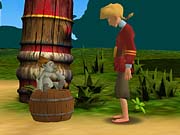
Interaction with other characters is also done by selecting different questions or responses from a text tree. Like most role-playing games, there's no right or wrong question to ask or way to respond to any character in Escape from Monkey Island. The more you talk with others, however, the more clues they'll reveal to you, making solving the game's puzzles somewhat easier. These puzzles should also prove somewhat less complex than in previous Monkey Island games. The designers aren't making them any simpler, though, just more intuitive. And like in LucasArts' more recent adventure games, a lot of smaller puzzles will be strung together to form a larger, overarching goal. For example, one of the game's first puzzles requires Guybrush to stop the aforementioned pirate from catapulting boulders at Elaine's house. When Guybrush speaks with him, the pirate mentions that he'd stop shelling the manor for a snack break. Guybrush then needs to head into a local pub to grab a bowl of jerky for the pirate, which is another puzzle altogether, and then find a rubber tube at a different location. Once these two items are in his possession, he has to head back to the pirate and successfully solve two additional puzzles before permanently putting a stop to his catapult.
Graphics
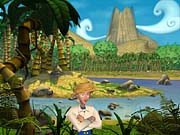
Like its gameplay, the graphics engine of Escape from Monkey Island is borrowed directly from Grim Fandango. In a move that has sparked some concern from dedicated Monkey Island fans, Escape from Monkey Island will now boast 3D polygonal characters and prerendered backgrounds. At its core, the technology behind Escape from Monkey Island is the same as Grim's, as is evident from watching the game in motion. However, there have been numerous enhancements made to the engine since Grim Fandango's debut two years ago. First, the designers opted to remove the software renderer altogether in favor of complete 3D support. Doing so allows the game to render its 3D characters with many more polygons and draw the backgrounds at full 32-bit color depth. Additionally, the character models in Escape from Monkey Island don't suffer from the same visible texture seams, tears, and clipping problems that occurred in Grim Fandango. This is largely due to the fact that each model is made up of nearly four times as many polygons as those in Grim Fandango. Manny, for example, was built using 400 polygons, whereas the new Guybrush is made up of 1500 polygons.
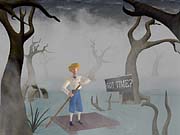
But Grim Fandango wasn't the only LucasArts game that Escape from Monkey Island borrowed technology from. Grim's animation system was torn out and replaced with, of all games, Obi-Wan's system. Stemmle explained that Grim Fandango's animation technology had no bone model or mesh deformation system, whereas Obi-Wan's did. As a result, the characters in the game move with a measure of fluidity and realism that was lacking in Grim Fandango.
Even though the backgrounds are just as detailed as other aspects of the game, they proved to be the biggest challenge for the artists at LucasArts. Unlike Grim Fandango's setting, the world of the Monkey Island series is bright and lively, and it looks distinctly like a cartoon. Conveying that feel was relatively easy in the previous Monkey Island games, since everything was hand drawn. But even the backgrounds in Escape from Monkey Island have to be rendered in 3D before being transposed into the game. Clarke and Stemmle credit the game's artists for successfully pulling off an animated look to the static backgrounds of Escape from Monkey Island. Clouds are displayed with gratuitous curves, and palm trees look like caricatures; the entire game looks very clean, and the 3D characters mesh beautifully with the 2D backgrounds.
Final Thoughts
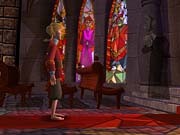
In the past 12 months, LucasArts has undergone a lot of changes in its staff and has lost a lot of top-level names. Among the key departures are Tim Schafer and Jack Sorenson, the company president. Last month, it was also revealed that the musical trio responsible for much of LucasArts' music - Clint Bajakian, Michael Land, and Peter McConnell - had also left the company to pursue their own interests. When Escape from Monkey Island was announced, fans of the series were looking forward to hearing the latest score from these three musicians but were soon disappointed to hear about their departure a few months later. During our visit to LucasArts, we inquired about their current whereabouts and were surprised to find out that all three had been contracted by the design team to write the music for Escape from Monkey Island. The entire score is very mellow and is made up of soft string instruments, steel drums, and flutes. The soundtrack really conveys the feeling of being on an exotic desert island... or in a travel agency.
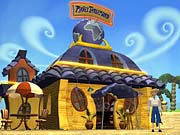
After playing the game, we walked away eagerly anticipating the release of Escape from Monkey Island. Though the game will undoubtedly please adventure game fans worldwide, one question begs to be asked. After the perceived commercial failure of Grim Fandango, why would LucasArts choose to develop another graphic adventure game, a genre that's more or less dead in the United States? According to company officials, the answer is simple: Grim Fandango wasn't a commercial failure. In fact, worldwide sales of Grim Fandango turned a respectable profit for the company, despite the shrinking adventure-games market in the US. "We believe there's still a market for these kinds of games because we know how to do them right," says LucasArts' international PR manager, Tom Sarris. "We look at the sales figures from a worldwide standpoint and ask ourselves if it still makes sense to make adventure games. Grim Fandango made a profit, so the answer is yes, it's still viable from a financial point of view." So what comes after Escape from Monkey Island? LucasArts didn't give us any details but made it clear that it would continue to invest in the adventure genre until people stop buying those types of games - good news indeed for fans of graphic adventures, who hold LucasArts to be the genre's premier developer.
As it stands now, Escape from Monkey Island is scheduled for a mid-November release. According to Stemmle, all that's left for the team to do is to "tighten some screws," render the final movie sequences, record a few more lines of voice acting, and of course, chase down all the bugs.
Got a news tip or want to contact us directly? Email news@gamespot.com
Join the conversation